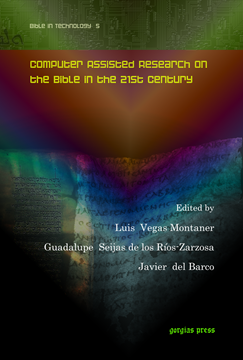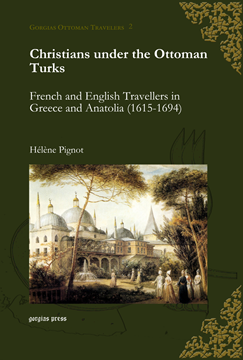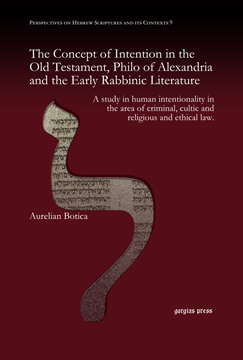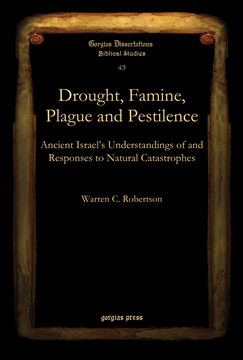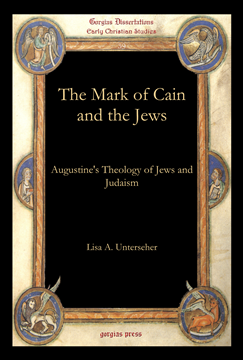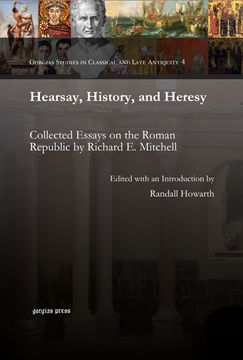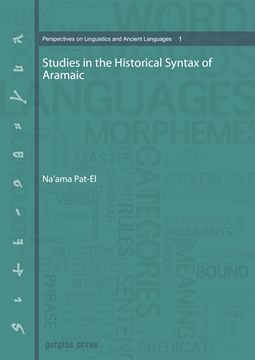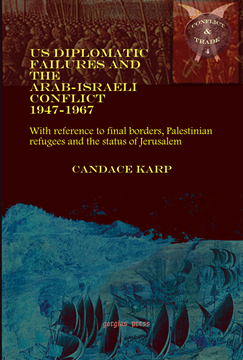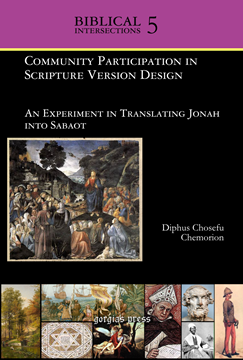Computer Assisted Research on the Bible in the 21st Century
ISBN: 978-1-60724-930-6
The application of computer technology to the edition and linguistic analysis of biblical texts has provided, in the last thirty years, advanced tools for research purposes as well as for teaching the Bible in the classroom. This discipline requires, nonetheless, a critical evaluation from a historical perspective, examining past and present achievements and failures. This collection of essays evaluates the current tools and considers what is needed to satisfy the increasing demand for software related to the biblical texts, and offers an overview of different trends in computer technology on the Bible.
$145.00 (USD) $87.00 (USD)
Christians under the Ottoman Turks
French and English Travellers in Greece and Anatolia (1615-1694)
Series: Gorgias Ottoman Travelers 2
ISBN: 978-1-59333-922-7
In the 17th century Britons left their country in vast numbers - explorers, diplomats, ecclesiastics, merchants, or simply “tourists.” Only the most intrepid ventured into the faraway lands of the Ottoman Empire. Their travel narratives, best-sellers in their day, provide an entertaining but also valuable testimony on the everyday life of Orthodox Christians and their coexistence with the Turks. Greek Christians, though living under the Ottoman yoke, enjoyed greater religious freedom than many of their brothers in Christian Europe. The travelers’ intellectual curiosity about Greece opened a window on the Orthodox Church, and paved the way for future dialogue.
$162.00 (USD) $97.20 (USD)
The Concept of Intention in the Old Testament, Philo of Alexandria and the Early Rabbinic Literature
A study in human intentionality in the area of criminal, cultic and religious and ethical law.
ISBN: 978-1-59333-653-0
Does God take into account only the physical act, or does He also consider intention? Does inward motivation truly matter in the areas of criminal or cultic law? Were there differences between the biblical, hellenistic and rabbinic views on intention? This book explores what the Old Testament, Philo, and the early Rabbis thought about human intentionality in a legal context.
$230.00 (USD) $138.00 (USD)
Drought, Famine, Plague and Pestilence
Ancient Israel’s Understandings of and Responses to Natural Catastrophes
Series: Gorgias Biblical Studies 45
ISBN: 978-1-59333-649-3
This interdisciplinary study integrates textual analysis of the Hebrew Bible and comparable ancient Near Eastern material with social theory and archaeology in order to articulate the ancient Israelites' taken-for-granted understandings of natural disasters, their intellectual and theological challenges to those understandings, and their intellectual and theological reconstructions thereof.
$135.00 (USD) $81.00 (USD)
The Mark of Cain and the Jews
Augustine’s Theology of Jews and Judaism
ISBN: 978-1-59333-896-1
This book examines the development of Augustine of Hippo’s theology of the Jewish people and Judaism. Formulating a typological association between the biblical figure of Cain and the Jews, he crafts a highly intricate theology that justifies and even demands the continuing presence of Jews and their religious practices in a Christian society. Such a theology emerges out of his highly original interpretation of Genesis 4:1–15 and yet mirrors and theologically justifies the reality of Jews and Judaism in the late Roman Empire.
$136.00 (USD) $81.60 (USD)
Hearsay, History, and Heresy
Collected Essays on the Roman Republic by Richard E. Mitchell
Edited with an Introduction by Randall Howarth
ISBN: 978-1-59333-642-4
A collection of articles by Richard E. Mitchell presenting all the major historiographical problems scholars encounter in reconstructing the early Republic. Mitchell was one of the first scholars to question the practice of taking the broad outlines of the accounts handed down by Roman historians (writing hundreds of years later) at face value in writing modern accounts of the period.
$177.00 (USD) $106.20 (USD)
Studies in the Historical Syntax of Aramaic
ISBN: 978-1-59333-645-5
Historical syntax has long been neglected in the study of the Semitic languages, although it holds great value for the subgrouping of this diverse language family. Focusing on the development of adverbial subordination, nominal modifiers and direct speech marking, as well as reviewing changes through language contact and drift, this book is the first step in the syntactic reconstruction of the Aramaic dialect group, the longest-attested branch of the Semitic language family.
$180.00 (USD) $108.00 (USD)
US Diplomatic Failures and the Arab-Israeli Conflict 1947-1967
With reference to final borders, Palestinian refugees and the status of Jerusalem
By Candace Karp
Series: Conflict and Trade 4
ISBN: 978-1-59333-273-0
The United States’ standing in the Middle East eroded as a result of its policy towards the Arab-Israeli conflict from 1947 to 1967, with Eisenhower’s “immediate deterrence” proving the lone exception. This period was especially critical as it introduced dynamics into the Middle Eastern balance of power that have proved particularly difficult to address. While the responsibility for seeking an end to conflict ultimately lies with the belligerents, the United States bears a heavy historical responsibility for the course of events and must now constitute the driving force behind a peaceful resolution of the dispute.
$193.00 (USD) $115.80 (USD)
Suryoye l-Suryoye
Ausgewählte Beiträge zur aramäischen Sprache, Geschichte und Kultur
Edited by Shabo Talay
Series: Bibliotheca Nisibinensis 1
ISBN: 978-1-59333-667-7
The present volume contains a collection of papers on different aspects of Aramaic linguistics, history and culture. These diverse papers are specifically intended for an informed Aramaic readership interested in raising awareness of their own culture. A fresh range of topics is therefore presented in this flagship volume of the series, offering a renewed vision of Aramaic and Syriac studies even for the specialists in the field.
$142.00 (USD) $85.20 (USD)
Community Participation in Scripture Version Design
An Experiment in Translating Jonah into Sabaot
Series: Biblical Intersections 5
ISBN: 978-1-60724-408-0
What strategies can be applied in producing an alternative version of Scripture that is complementary to the existing translation(s) and acceptable to the target audience? This book answers this question by exploring a theoretical strategy for this purpose. On the basis of Christiane Nord’s functionalist theory of translation, the author of this book formulated a Participatory Approach to Bible Translation and experimented with it in translating the book of Jonah into Sabaot, a Kenyan language. This book provides an excellent model for involving communities in the production of Scripture translations.
$178.00 (USD) $106.80 (USD)
